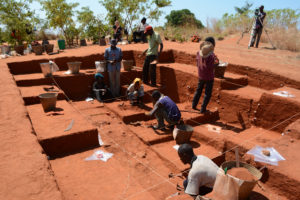
Science Advances—Helping to illuminate the origins of ecosystem-changing behavior in humans, a new study based on a 636,000-year sedimentary record in northern Malawi suggest that fires set by humans in the Middle Stone Age influenced vegetation composition and erosion there. The findings indicate that changes in climate alone cannot explain these ecosystem shifts, and shed light on how modern humans became a globally dominant species. Modern humans have extensively and intentionally transformed ecosystems for tens of thousands of years. However, while a growing body of evidence suggests ecosystem modification behaviors were fundamental to human evolution, the origins of this behavior have remained unclear. To better understand the extent to which fires set by early hunter-gatherers may have reconfigured the landscape, Jessica Thompson and colleagues extensively dated sedimentary records from the Stone Age landscape in southern-central Africa. They found evidence for human occupation in the region dating back about 92,000 years, based on sedimentary deposits in the Chitimwe Beds at the northern end of Lake Malawi. The researchers also surveyed 147.5 linear kilometers, established 40 geological test pits, and analyzed more than 38,000 artifacts from 60 locations, finding extensive evidence for early modern human activities in northern Malawi. They also identified increased charcoal abundances beginning roughly 150,000 years ago, indicating heightened fire frequency. Fossil pollen analyses indicated vegetation disturbances beginning around the time that human occupation began, and further revealed that species richness in the region has been 43% lower over the past 85,000 years than during previous periods. Together, the data suggests that fires set by early humans meaningfully reshaped the northern Malawi landscape. “In the modern context, anthropogenic landscapes persist and have intensified following the introduction of agriculture, but they are extensions, not disconnections, of patterns established during the Pleistocene,” Thompson et al. write.
____________________________

The research team exposes ancient stone tools at the Sadala South I site near Karonga, Malawi. Jessica Thompson
____________________________

The Ngara I site near modern-day Chilumba in Karonga, Malawi. Jessica Thompson
____________________________

Excavation in progress on a slope near Vinthukutu Forest in Karonga, Malawi. Jessica Thompson
____________________________
Article Source: Science Advances is published by AAAS, the nonprofit science society.
____________________________
Advertisement



